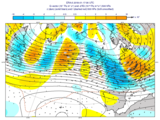q_vector
- q_vector(t, z, static_stability=2E-6, coriolis=None)
Computes the Q-vector used in the quasi-geostrophic (QG) theory. It can determine the forcing for vertical motion in mid-latitude synoptic scale weather systems.
- Parameters
t (
Fieldset) – temperature (K) on pressure levelsz (
Fieldset) – geopotential (\(m^{2} s^{-2}\)) on the same pressure levels aststatic_stability (number or ndarray or
Fieldset) –static_stability()parameter (\(m^{2} s^{-2} Pa^{-2}\)). In the QG theory this is a constant on a given pressure level. If it is specified as an ndarray it must define a value for each pressure level intandz. It is also possible to use aFieldsethere. In this casestatic_stabilitymust contain either a single field or as many fields as there are intandz.coriolis (number) – set a constant Coriolis parameter value (1/s) for the
geostrophic_wind()computations. If it is None (the default) the real Coriolis parameter is computed for each gridpoint.
- Return type
The result is the Q-vector in \(m^{-2} s^{-1} Pa\) units as defined in [Bluestein1992]:
\[\vec{Q} = - \frac{R_{d} {T}}{\sigma} (\frac{\partial \vec{v_{g}}}{\partial x} \nabla T, \frac{\partial \vec{v_{g}}}{\partial y} \nabla T)\]where
\(R_{d}\) is the specific gas constant for dry air (287.058 J/(kg K))
\(\sigma\) is the
static_stability()\(\vec{v_{g}}\) is the
geostrophic_wind()computed as:\[\vec{v_{g}} = (-\frac{1}{f_{0}} \frac{\partial z}{\partial y}, \frac{1}{f_{0}} \frac{\partial z}{\partial x})\]where \(f_{0}\) is a constant Coriolis parameter defined by
coriolis. However, ifcoriolisis not specified the real Coriolis parameter is used in each gridpoint.
The Q-vector gains importance because the QG omega equation can be written as:
\[(\nabla^{2} + \frac{f^{2}_{0}}{\sigma} \frac{\partial^{2}}{\partial p^{2}}) \omega = -2 \nabla \vec{Q}\](after ignoring the term containing \(\frac{\partial f}{\partial y}\) on the right-hand side). Thus \(-2 \nabla \vec{Q}\) determines the forcing for vertical motion.
Some remarks on the use of
q_vector():when using NWP fields to compute the Q-vector (or the \(-2 \nabla \vec{Q}\) term) the results are usually extremely noisy due to the product of spatial derivatives. Therefore it is advised to apply a smoothing or spatial filter on the input data even when the grid resolution is low (see Chapter 2.3. of [Lackman2012]).
the equations in the QG theory are derived in an orthogonal Descartian co-ordinate system. However, in Metview the horizontal derivatives are always computed on the sphere. Therefore some of the assumptions in the QG theory, e.g. the divergence of the geostrophic wind as defined above is always zero, will not be true.
the derivatives are computed with a second order finite-difference approximation. The resulting fieldset contains two fields for each input field: the x and y Q-vector components. In each output field the points close to the poles and the Equator are bitmapped (they contain missing values).
Warning
q_vector()is only implemented for regular latitude-longitude grids.Note
See also
static_stability()andgeostrophic_wind().
